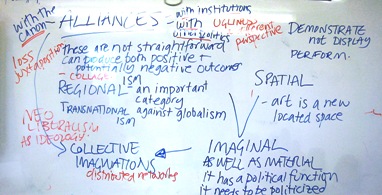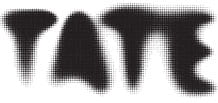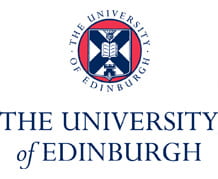Pavilion Parade, University of Brighton – 12 March 2011
‘Feminisms 2011’ Programme
Morning
- Marsha Meskimmon (Loughborough) ‘Wack! and After’
- Suzana Milevska ‘What is it like to be a feminist curator in the Balkans?’
Afternoon
- What can we make of “the goat”? Rauschenberg’s Monogram(1955-59) from feminist and queer perspectives (Jessica Sjoholm Skrubbe and Matt Smith) short presentations, followed by discussion
- Closing discussion followed by drinks reception at Grey Area Gallery
Notes by Lara Perry (chair)
Marsha Meskimmon – ‘Wack! and after’
Professor Meskimmon’s address to the meeting addressed three different aspects of feminism and curating that relate to her own projects and analysis.
The first part of her paper reflected on trends or strategies that appear feminist curating projects, a) the identification of a regional movement (not that this is straightforward, an issue that manifested itself in the tension between American exhibitions ‘Wack!’ and ‘Claiming Space’) b) surveying feminism through a Benjaminian notion of the past (e.g. ‘Inside the Visible’/’And the One Doesn’t Stir Without the Other’) and c) exhibitions that might be described as ‘area studies’, (e.g. Text and Subtext: Contemporary Art and Asian Women). She noted that feminist shows often ‘explode’ the exhibition through education and other activities.
Meskimmon then addressed ‘the curatorial turn’e in which the curator has become aware of the exhibition as embodied knowledge or situated experience, and addresses the exhibition not as presentation but as demonstration. Meskimmon associated this kind of practice with the work of curator Maria Lind, historian and critic Jane Rendell, and with the collaborative exhibition project ‘Materialisations’. Meskimmon offered a suggestive discussion of the exhibition being conceptualised as ‘an indeterminate space of pure possibility’ in which the material world is imaginitively reworked (her references for this included Edward Casey, Elizabeth Grosz, Rosi Braidotti).
Finally Meskimmon explored the ways in which feminist research and curatorial practice shares concerns with drawing research and curatorial practice, in their mutual interest in work of ambivalent status, and focus on practice/performativity.
The discussion pursued the question of the exhibition imagined as a space of imaginative transformation, which (Monica Ross observed) has particular resonance with how many artists conceive of their practice. Observations were offered about the relation between time and space that were evoked by particular exhibition strategies, and the way that space can offer a radical relation to the past. The discussion also clarified Meskimmon’s conceptualisation of the exhibition as imaginative space that is still material, politicised, and not simply a carnivalesque inversion.
Suzana Milevska: ‘On being a feminist curator in the Balkans’
Suzana Milevska’s paper addressed the specific conditions of curating as a feminist in the Balkans, which is without the history of feminist practice and debate present in Eastern Europe (which is she contended might already be considered Western Europe). The Balkans offers a distinctive combination of Ottoman, Communist and neo-liberal colonial legacies. Milevska was careful to avoid essentializing women curators and distinguished between practices that explicitly addressed feminism; or were by women but not feminist; or which addressed gender difference and the social but did not identify with feminism. The latter is a perspective that she frequently encounters in Macedonia.
Suzana described different artworks and exhibitions which she had curated, and reflected on how they responded to the particular forms of patriarchy present in Macedonia. The works discussed included Žaneta Vangeli’s Macedonian Social Sculpture (1996); Marina Abramovic’s The Bridge (1996); Tanja Ostojic’s Looking for a husband with EU passport (2001-06) which was instigated through a show curated by Milevska in 2001 called Capital and Gender; and ‘Peep Show’ in Skopje, which attracted a lot of attention from people who saw the publicity although the show itself did not (much) fulfill the promise of a ‘peep’.
Suzana argued for the presence of a regional feminist knowledge that was a supplement to the local and the national, and noted that while the region had been a major part of the curatorial remit of the MUMOK show Gender Check: Femininity and Masculinity in the Art of Eastern Europe (2010), the final presentation of the work in exhibition and in catalogue completely flattened any regional difference. She concluded her paper with an exhortation to find theoretical models of subjectivity that elaborated forms of agency; imperative as in Macedonia the forms of gender equality that had been present under socialism are being rapidly eroded (and Angela Dimitrakaki commented that the same was happening in ‘the west’).
Discussion following Suzana’s paper included reflections on the differences between gender awareness and feminism; and also about the extent to which feminists can achieve political agency through other political movements.
‘Getting the Goat – Reflections on Robert Rauschenberg’s Monogram at the Moderna Museet’
This part of the seminar was given over to two short discussions of Rauschenberg’s Monogram – commonly known as the Goat – at the Moderna Museet, as a mechanism for exploring the relations and differences between feminist and queer curating practices.
Jessica Sjoholm Skrubbe described the role of Rauschenberg’s Monogram as a key piece in the Moderna Museet’s presentation of itself as a collection of high modernism. Its emblematic function makes it a likely if arbitrary candidate for removal from the Moderna Museet display/collection in order to accommodate the history of women’s art practice in modernism. Jessica argued that the recent initiative to add women’s work to the collection, named under the title ‘The Second Museum of Our Wishes’, merely filled gaps in the existing narrative, rather than reflecting a changed understanding of modernism that should and could result from gender analysis.
Matt Smith presented a re-reading of Rauschenberg’s Goat that emphasised its function within gay (rather than queer) context that relates to its historical moment of origin. Matt was keen to emphasise how the collage/combine medium was suited to conventions of semiotic repurposing that was evident in gay culture in 1950s America. There are reasons to associate this practice particularly with Rauschenberg, and different ways to read the object(s) involved and their relations (the goat, backed through a tire, on a platform) that invite a reading of the work as a declaration of homosexual identity that is typically repressed in museum discourse.
The discussion that followed posed the question ‘does the queering of “The Goat” unsettle the masculinist narrative of the Moderna Museet’? Sue Malvern advanced the position that it could not, because male artists’ work persists in the dominant position. Matt argued that the problem was a masculinist rather than a male view, and that the queer reading of Rauschenberg’s work is obviously subversive since it is cloaked by standard museum narratives.
We also discussed the necessity of ‘losses’ in the collection, since one of the imperatives of museum collections is conservation and preservation. Katrin Kivimaa suggested to Jessica that the addition of women’s work to the Moderna Museet displays following the ‘Second Museum’ campaign did have a discernable impact on the character of the presentation, and that it did matter. Jessica maintained the position that the ‘Second Museum’ did not challenge the conventional understanding of modern art, and that the ‘loss’ of canonical work from the museum collection is not more problematic than the irrefutable losses of women’s cultural production.
Lara Perry, Chair May 2011
Participants
Marsha Meskimmon is the author of books about women, gender and art including We Weren’t Modern Enough: Women Artists and the Limits of German Modernism (1999) and Women Making Art: History, Subjectivity, Aesthetics (2003). Her recent Contemporary Art and the Cosmopolitan Imagination (2010) explores the dynamics of ‘belonging’ – of being ‘at home’ – in contemporary transnational art. She has also been involved with several curatorial projects, including WACK! Art and the Feminist Revolution (2007).
Suzana Milevska is a Lecturer of Art History and Theory at the Faculty of Fine Arts/ Ss. Ciryl and Methodius University in Skopje. She has curated over 50 exhibitions and international projects in Skopje, Istanbul, Stockholm, Berlin, Stuttgart and Bonn, and she was a contributing curator to the major exhibition ‘Gender Check’ (Vienna MUMOK, 2009-10).
Jessica Sjoholm Skrubbe is a research fellow in the department of Art History at The University of Stockholm. She is co-editor of Feminisms is Still Our Name: Seven Essays on Historiography and Curatorial Practices (Cambridge Scholars, 2010).
Matt Smith is a ceramicist and curator studying for his PhD at the University of Brighton (2011). He is curator of the current exhibition ‘Queering the Museum’ at the Birmingham Art Gallery.










Leave a Reply